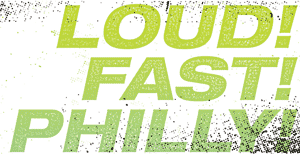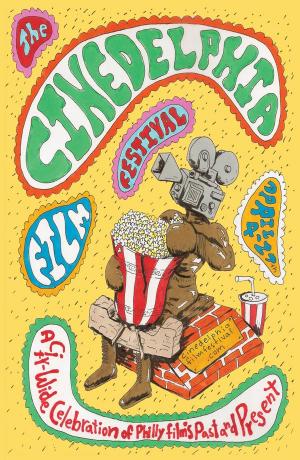Screen Invasion Reviews L!F!P! at the Cinedelphia Film Festival

Welcome to Screen Invasion’s coverage of the first annual Cinedelphia Film Festival, a celebration of the City of Brotherly Love’s lesser known cinematic history (the motto: “we’re more than just Rocky”). A month long filmic carnival running from April 4 – 27, the Fest offers everything from a tour of The Stoogeum, a local museum dedicated solely to the Three Stooges, lost or little seen short & repertory films, and full blown local premieres, such as the Fantastic Fest favorite, Vanishing Waves. If you’re in the area, join in on the fun, and if you’re a SI reader, get ready for select coverage of Cinedelphia’s feature film selections.
Our fifth night at the mausoleum saw us indulging in an audio/visual history of Philadelphia punk and hardcore music, as told by scene lifer Joseph Gervasi…
What separates a true historical exhibition from a simple nostalgia piece? At what point does watching YouTube style amateur videos reveal nothing more than the presenter’s enjoyment of a particular genre or scene? Does a retrospective without a thesis provide any kind of value (artistic, historical or otherwise) besides submitting the collector’s skewed viewpoint for other like-minded individuals’ approval? Or is it simply no different than a journal, telling the tales of a single person’s recollections of their experiences in a certain time or place?
Joseph A. Gervasi has been a lifer inside the Philly punk and hardcore scenes for nearly thirty years. A founder of the ’90s DIY show-runners, the Cabbage Collective, repertory screening group Exhumed Films (who previously put on a showing of The Mutations for CFF) and import home video haven, Diabolik DVD, he’s the very embodiment of the “self-made man”. Diminutive in stature with a disarmingly polite demeanor (seriously, this guy could stab you and make you feel OK about becoming a victim to his violence), his approachability is what attracted me to LOUD! FAST! PHILLY!, an A/V documentation of Philly’s hardcore punk scene from the 80s up to modern day.
The result is a project presented in two parts: a screening of rare punk footage (which I attended Tuesday night), that was augmented with live commentary from different members (bands, singers, promoters, organizers) of the scene. The second part is an expanding audio archive of frank, unedited interviews chronicling just what the time spent inside of the punk scene meant to all who participated. Each interview is accompanied by stunning B&W portraits of the subject(s) by photographer Karen Kirchhoff, displaying stark “where they are now” illustrations of the once wild.
Youth culture, like youth itself, is precious and fleeting. Those who engage fully with life soon learn to inhabit each moment of their life and infuse it with meaning. It is the ephemeral nature of the moments that make up one’s life that causes some to long for the past while others move into the future with enthusiasm.
The greatest praise I can give Joseph’s presentation is that I left PhilaMOCA Tuesday night alive and invigorated. The footage presented captured a spirit that every person on Earth, man or woman, experiences during their time on the planet. It’s the feeling of being young and free and angry, and wanting to share these emotions with those who feel the same. It’s also a reminder that life is short, and that you have to experience all you can during the very limited time you are given here (there is a constant theme to Gervasi’s recollections revolving around the fact that many who lived through these times are now, in fact, no longer living). The ability to capture that spry spark is rare, and Gervasi’s exhibition had it in spades.
It wasn’t until later that the flaws in the presentation stuck in my craw. Even though Gervasi says that he wants to exhibit the footage without any kind of thesis, it still feels biased in how its all laid out. What kept coming back to me were moments contained inside of the tapes (there’s a very analogue feel to LOUD! FAST! PHILLY!, right down to the mix cassettes of prog and punk handed out at the door) that felt as if they could explode into violence at any moment. Gervasi is even threatened at one point to “get the fucking camera out of my face” by one crusty punk sitting outside of a venue on a cracked stretch of sidewalk. Another kid is punched and thrown out of famed underground warehouse space Stalag 13 for being “too annoying”, something the crowd ate up and Gervasi even joked about during his intro to the footage. While I do admit, as someone who has attended hundreds of live shows in his lifetime, that there almost always is one “annoying kid” who needs to be dealt with at every performance, the footage hinted at an uglier side of the scene that exists, but went wholly unpresented by the visual component of LOUD! FAST! PHILLY! This omission begged the question: “what happens when the ‘healthy outlet’ turns violent, going against everything that the musical collective stands for?”
The footage isn’t the only part of the program that hints at the seedier aspects of the punk scene. During his interview with More Fiends’ Elizabeth and Allen Fiend, the two ’80s punks recount a time when Gary Heidnik, noted mass murderer and serial rapist, frequented many of their shows at a popular venue (Abe’s Steaks at 48th and Market). As Elizabeth Fiend recollects:
Abe’s was actually a luncheonette, and the guy, Abe, who owned the place, kind of collected ‘down and out’ people and he gave them lodging upstairs above the luncheonette. And there was some talk that maybe he was helping them, or maybe he was using them; there was a fine line. He’d collect their welfare checks or, whatever they were getting, and he’d keep the money and make sure they had food and a place to stay. And Gary Heidnik didn’t live there, but he was one of the odd types of people who hung out there…he was part of ‘Abe’s Army’.
While it’s impossible for Gervasi (or any curator for that matter) to present every detail of the subject they are documenting, the joking nature in which the violence was introduced made the visual side of the presentation feel more like a trip down memory lane than it did the unbiased presentation of fact Gervasi claims LOUD! FAST! PHILLY! is during his written intro. And even though there were live interviews with some of the subjects presented during the night, they tended to lean more toward the same, upbeat sense of ‘nostalgia’. While I have no doubts that Gervasi’s intentions are pure (he admits to omitting ‘embarassing’ footage of two fans hashing out their differences on stage as he didn’t want to ‘make fun of them’), I think that divorcing the video portion of the project from the audio interviews lent it a somewhat confusing tone. And while he says that LOUD! FAST! PHILLY! is by no means a “documentary”, maybe the combination of the two elements would help unify the piece’s overall message. Despite its creator’s statements otherwise, I do believe the program contains a defined premise, and that is to present the invigoration of youth the scene provided, and to show just how meaningful these times were to those who lived (and continue to thrive) through them.
Whatever my issues overall, they are seemingly minor, and I do want to stress here, more than anything else, that what Joseph Gervasi is doing with LOUD! FAST! PHILLY! is important. He’s giving a voice to the artists that time usually forgets. Those who helped populate this scene with the music it celebrated weren’t huge selling artists or chart toppers. They were kids who picked up a guitar and tapped their buddies on the shoulder, wanting nothing more than to share the frustration, angst and anger they felt everyday. They were there to unite with others who felt just like they did, and to share a collective voice that went unheard throughout most of their daily lives. This is vital to any culture, especially one that is as overrun with violence as the modern United States. To forget those who encouraged healthy emotional outlets would be a crime, as we need them now more than ever. In closing, I leave you with the final paragraph of Joseph’s introduction to the project:
There are many, many people I’d love to talk to, but I will only do these interviews in person and many crucial players in Philly’s punk scene are scattered to the four winds. I will, however, endeavor to track them down and capture their voices. As well, there are many locals I’d love to sit down with. Time is tight, but the desire remains to make this mosaic something that, when taken in pieces or as a whole, is beautiful and inspires the listener to do as these interviewees have done: be active and contributing participants of their times. This is the only life you’ll ever have and what you choose to do with it and how you treat everyone and everything around you makes a massive difference. You matter and people love you. As the band Scram! sang, “Forward, onward!”
Godspeed, sir. You keep recording them, and I’ll keep listening.

